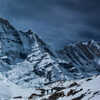
"न तत्र सूर्यः भाति न चन्द्रतारकं
नेमा विद्युतो भान्ति कुतोऽयमग्निः।
तमेव भान्तमनुभाति सर्वं
तस्य भासा सर्वमिदं विभाति॥"
—
Kathopanishad 2.2.15
"There, the sun does not shine, nor the moon, nor the stars. Lightning does not shine there, nor does fire. It is by His light that everything shines."
This verse describes the divine abode where light itself seems to bow before the eternal radiance. For many, this perfectly fits Mount Kailash — a mountain that stands beyond time, science, and human understanding.
Located in western Tibet, about 1,200 km from Lhasa and nearly 3,000 km from Delhi, Mount Kailash rises 6,638 meters above sea level. It is revered as Lord Shiva’s abode, and every year, thousands of pilgrims risk thin air and freezing winds to circumambulate it. Yet, no one has ever climbed it — nor has anyone truly understood it.
1. The Perfect Pyramid
 Mount Kailash’s structure is strikingly geometric. Its four symmetrical faces align almost exactly with the cardinal directions — north, south, east, and west. Some geologists have called it the most perfect natural pyramid on Earth, while others suggest it may not be entirely natural at all.
Mount Kailash’s structure is strikingly geometric. Its four symmetrical faces align almost exactly with the cardinal directions — north, south, east, and west. Some geologists have called it the most perfect natural pyramid on Earth, while others suggest it may not be entirely natural at all.
Its angles and precision appear beyond what erosion could create. Satellite images even show smaller pyramid-like formations surrounding it, as if forming part of a vast ancient design. Science has no clear explanation, and the mountain’s symmetry remains one of its most baffling traits.
2. The Unclimbed Peak
 dogs become mountain companions. No one has ever successfully climbed Mount Kailash. This isn’t due to mere difficulty but to a series of mysterious and spiritual prohibitions.
dogs become mountain companions. No one has ever successfully climbed Mount Kailash. This isn’t due to mere difficulty but to a series of mysterious and spiritual prohibitions.
In 1926, Swedish explorer Sven Hedin attempted to scale Kailash but turned back after witnessing sudden weather shifts and unnatural rock formations. Later, in 2001, when the Chinese government allowed a Spanish team to climb it, there was such global spiritual outrage that the permit was revoked. Even the climbers themselves withdrew, saying it felt wrong to “trespass the home of the gods.”
Those who have ventured too close have reported rapid hair and nail growth, severe dizziness, and unusual time distortion — phenomena that have been documented by both explorers and locals. Some accounts suggest that people who spent even a single day near the mountain’s base felt as though weeks had passed when they returned.
Whether these experiences are caused by strong magnetic fields, gravitational anomalies, or psychological effects of altitude, no scientific explanation has yet been found. What remains undeniable is that no living being is allowed to step on its peak, as if an invisible law of nature protects the sanctity of Kailash.
3. The Center of the WorldIn Hindu, Buddhist, and Jain traditions, Kailash is called Mount Meru, the Axis Mundi — the spiritual center of the universe. Strangely, global mapping shows that Kailash lies near the geometric center of many ancient sacred sites across continents.
Moreover, pilgrims claim that circumambulating Kailash (the
Kora), a 52-kilometer trek around its base, generates a powerful energetic effect. Some say it restores health or brings inner awakening. Many also report that time seems to shift — with the 3-day pilgrimage sometimes feeling like mere hours.
Scientists who measured the region found unusual geomagnetic readings and electromagnetic activity, though not enough to explain the transformative effects devotees experience. To billions across Asia, this mountain isn’t a place on Earth — it
is Earth’s heart.
4. The Twin Lakes
Despite their closeness, they remain chemically opposite — one nourishes, the other corrodes. Science cannot explain how two adjacent lakes maintain such stark contrast. It is said that Kailash keeps them apart, balancing light and darkness in its own shadow.
5. The Time Distortion MysteryMany travelers claim that time behaves differently near Kailash. Watches stop working, hair and nails grow faster, and days seem to pass in hours. Russian studies once recorded unusual magnetic fields around the region, possibly affecting human perception and instruments.
While scientists call these stories psychological or altitude-related, the consistency of reports over centuries suggests something deeper — as if time itself bends in reverence to the mountain.
-
Mutated flu virus could wreak 'worst season in a decade'

-
Channel 4 Gogglebox star 'retires' as co-star 'has to find replacement'

-
Why Nitish Kumar's Rs 10,000 scheme is not swaying women voters in Bihar

-
Obscene stunt: Woman dances naked from the window of a moving car, video goes viral

-
What are triglycerides: All about their impact, and how to bring them down
